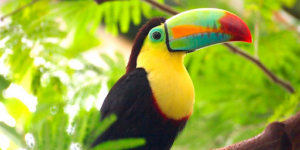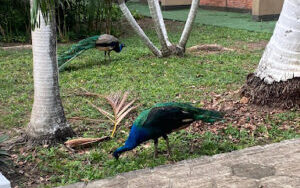Costa Rica is a beautiful land filled with a variety of flora and fauna across the entirety of its land, sea, and sky. With roughly half of its land mass consisting of rainforests and an estimated 5% of the world’s biodiversity, Costa Rica has the highest biological density compared to any other country in the world. From monkeys to jaguars to parrots, the local wildlife within the country has played a key role in developing the nation’s own cultural identity along with aiding in their own economic growth via tourism.

Figure 1: Toucan photographed in the Costa Rican rainforest, one of the many examples of the nation’s biodiversity
Within indigenous populations, local wildlife has had a prominent impact on many aspects of their culture such as their traditions, celebrations, clothing, etc. The Brunka ethnic culture, one of the few remaining indigenous cultures left, holds an annual celebration known as Juego de los Diablitos or ‘The Dance of the Devils.’ During the celebration, people dress up in various symbolic masks and costumes and hold a performance depicting the story of the Spanish conquest of the local indigenous tribe. The tradition itself represents the ongoing struggle to preserve the nation’s culture in the face of modern adversity through the use of various wildlife imagery. Costumes and masks with the likeness of bulls represent the Spanish invaders as various devils with animalist characteristics battle them in the streets. Masks depicting local fauna to represent different groups within their stories is a staple of this tradition and demonstrates how intertwined the nation’s culture is with their surrounding wildlife.

Figure 2: ‘The Dance of the Devils’ an indigenous traditional celebration
In addition to influences found in indigenous cultures, Costa Rican wildlife itself has made itself to be a very prominent factor in generating the country’s tourism. One of the leading economic sectors of the country is tourism, making up about 5.5% of the nation’s total GDP leaving the country highly dependent on the revenue gained from visiting tourists. Part of this high tourism rate can be attributed to the local wildlife within the national parks and reservations spread across the country. In my own experience visiting Costa Rica, natural wildlife and its impact could be seen everywhere. From the peacocks roaming in the courtyards to the occasional lizard darting around the ceilings, wildlife whether intentional or not was a large part of the tourist experience. Costa Rica’s animal impacts even extended as far as to be a main feature of their local souvenirs. Hand-crafted mugs with sloths painted on them and magnets with bright red macaws dominated every local gift shop we visited. It was physically impossible to visit a gift shop without seeing at least one animal-themed t-shirt or hat. People from a variety of different nationalities and backgrounds visit Costa Rica to experience the natural environment and wildlife which manifests throughout the country’s many tourist attractions and merchandise.

Figure 3: Peacocks photographed at a hotel in Liberia
While beneficial to the nation’s economy, this dominating industry has had a veritable negative impact on the ecosystem in the past as an increase in tourists directly resulted in an increase in hotels in the nineties leading to a deforestation crisis. However, in recent years the country has recognized this problem and implemented green policies in an effort to protect and preserve the natural environment. These protections ranged from the introduction of sustainable energy options to various protections placed on endangered species. Costa Rica’s government recognizes the important role wildlife plays in the country’s rich cultural heritage and economic development.
From its economy to its culture, Costa Rica relies heavily on the conservation and protection of the natural wildlife existing in their rainforests. Various indigenous cultures implement aspects of their wildlife into their traditions and celebrations leading to an increase in tourism and thus an increase in the country’s overall economic growth. Biodiversity is an important aspect of a nation’s overall identity and we as citizens of the United States should recognize this and push for more policies that focus on the protection of our own native wildlife.
Sources
https://www.earthlawcenter.org/blog-entries/2019/1/costa-rica-paving-the-way-for-rights-of-nature
https://www.vacationscostarica.com/travel-guide/indigenous-art-and-crafts/
https://www.thefreelibrary.com/Ecotourism+in+the+national+parks+of+Latin+America.-a014785910
https://doi.org/10.5751/es-13529-270416
https://www.propertiesincostarica.com/blog/wildlife-in-costa-rica/
Photos
Figure 1: https://www.propertiesincostarica.com/blog/wildlife-in-costa-rica/
Figure 2: https://www.vacationscostarica.com/travel-guide/indigenous-art-and-crafts/
Figure 3: Photo Taken by Matthew San Miguel